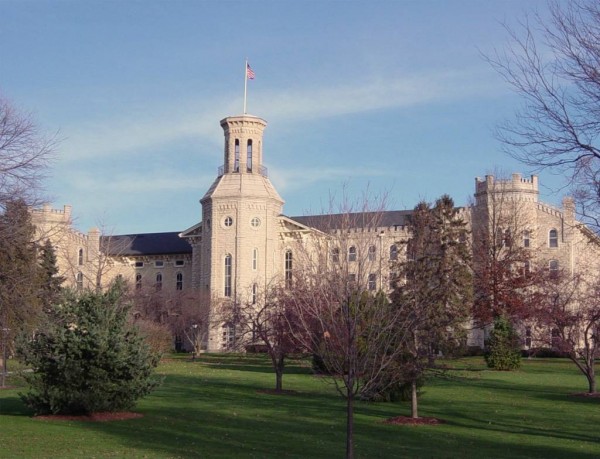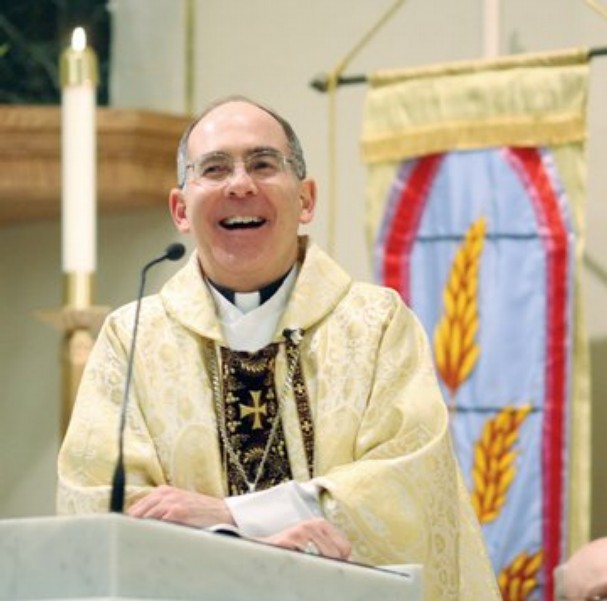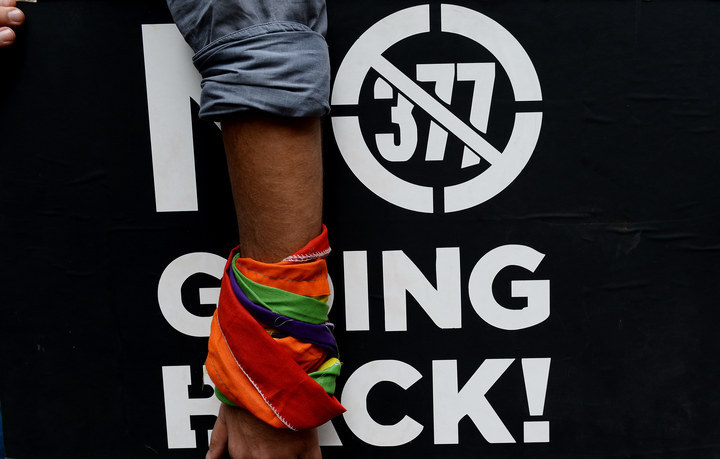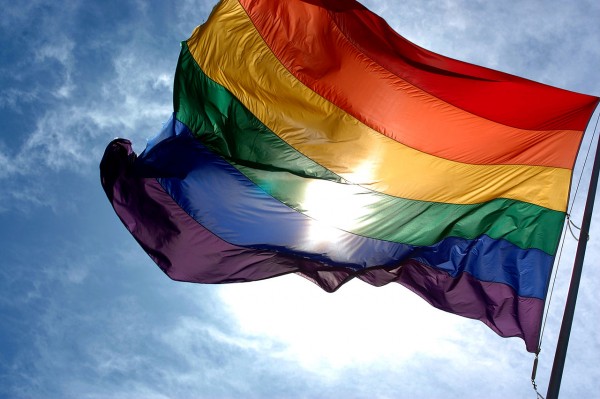 After Modern Family, over glasses of soda and water (this is a Christian crowd, after all), the group watches a video produced for a college project by one of the students about life on campus. There are several scenes of Wheaton kids walking around the school. It was shot so their faces could not be seen.
After Modern Family, over glasses of soda and water (this is a Christian crowd, after all), the group watches a video produced for a college project by one of the students about life on campus. There are several scenes of Wheaton kids walking around the school. It was shot so their faces could not be seen.
The director points out which body parts belong to other known LGBT students on campus: “He’s gay, she’s gay, he’s gay,” they say every time a familiar shoulder blade or set of feet flashes on screen. The four others at Wiens’ house applaud after the video was over. Knowing which feet are gay: This is progress.
Imagining a Wheaton where showing openly gay students’ faces on video would be okay? It seems years, even decades away.
It’s easy to forget, at least in places like New York or San Francisco, that the Supreme Court struck down the important parts of the Defense of Marriage Act less than three years ago. In an age when gay people are featured as main characters in TV shows, lauded by pop stars, and show up regularly in The New York Times real estate section pieces like any other annoyingly wealthy couple on the hunt for an overpriced apartment, it’s easy to forget there’s another America, the GOP’s “real America,” the one where being gay is still a thing.
Wheaton College—nestled in the heartland, yet kissing a city border— might be a barometer for that America.
Boystown, the Chicago neighborhood where opening Grindr might cause your phone to explode, is only an hour away by train. But the small city of Wheaton feels stuck in time, immune from the social and economic pressures of the last decade. Its large brick and white wood houses are nearly all framed well by Christmas decorations in early December. Its quaint downtown streets show no sign of anything that could be deemed family-unfriendly. The town is rumored to have the most churches per capita of any place in America. Wheaton was a dry city until 1985.
And the college, located on a hill as if it were the centerpiece of the town, is known as the “Harvard of Evangelical colleges.” When the administration began termination procedures for a professor who stood in solidarity with Muslims by wearing a hijab to class, it made national news for weeks. Every move Wheaton makes, one prominent Evangelical told me, sends shudders through the rest of conservative Christian America.
So when LGBT students and alums come together here to meet and to push the administration toward acceptance, it could have ramifications far beyond campus borders. Wheaton College could be a canary in the mine for gay acceptance in this other America, the one forgotten by the relentlessly upbeat coverage of gay rights in major cities.
The fact that any students are willing to meet with me was a sign of momentum. A few years ago this story likely wouldn’t have even been possible. But Wheaton’s campus is still light years away from being a queer haven. The college’s administration believes Christ can help change sexuality. Its “Community Covenant,” a document every incoming student is required to sign their first day at school, prohibits “sexual immorality,” and that includes “homosexual behavior.” When I asked the college’s PR person LaTonya Taylor whether the college would affirm same-sex relationships, her answer was clear: “No.” (And then she directed me to the Community Covenant.
When Wiens went to Wheaton, first as an undergrad in the mid-1990s and then as a grad student in the school’s psychology program ten years later, coming out was out of the question. The psychology department didn’t outright teach conversion therapy—the much-discredited practice of psychologists coaching people to change their sexualities, banned in several states—but professors made clear their feelings about sexuality in other ways.

“The assumption was still that it is a sin,” Wiens says. “There were comments that were ignorant or homophobic being made pretty much every week. It was definitely not a comfortable place to be.”
For decades after Wheaton, Wiens and other LGBT Wheaton alums kept in touch only through a newsletter sent out sporadically by one alum. In 2011, Wiens and a few dozen others launched OneWheaton, a support and advocacy group that now throws annual homecomings for LGBT Wheaton grads each year near the school. Wiens is now the organization’s chair. The school won’t allow it to be held on campus, but because it’s an alumni group, OneWheaton has the privilege of being public and proud about sexuality.

“Your sexual identity is not a tragic sign of the sinful nature of the world,” the group’s founding letter reads. “You are not tragic. Your desire for companionship, intimacy and love is not shameful. It is to be affirmed and celebrated just as you are to be affirmed and celebrated.”
There hasn’t been much policy progress made at Wheaton in the four years since then, but Wiens says the comfort levels of the students have increased tremendously. The fact that on many Thursdays somewhere between three and 10 students come to her house and talk openly about being gay, about wanting boyfriends or girlfriends, is proof.
Still, Wiens says, she worries about the risks inherent in becoming more comfortable.
“The undergrads, they skate on thin ice,” she says. “You can still get expelled for being in a relationship. Professors can still be fired for saying homosexuality isn’t a sin. I don’t think they realize how much they’re at risk.”
There aren’t any known cases where professors have been fired just for supporting the LGBT community. At least explicitly. The professor suspended after wearing a hijab was already on thin ice after the administration spotted a picture of her on Facebook at Chicago’s gay pride parade. In 2014, the school hired Julie Rodgers, a lesbian who had vowed to remain celibate in order to keep from sinning, as a spiritual counselor. But in the summer of 2015, Rodgers wrote on her personal website that her views on sexuality had “evolved,” that she viewed same-sex relationships as okay.
“I’ve become increasingly troubled by the unintended consequences of messages that insist all LGBT people commit to lifelong celibacy,” Rodgers wrote.
She left the school. Even though she wasn’t technically fired, students and alums say there was no way she could have stayed.
There’s a generational divide at Wheaton. It’s hard to find Wiens’ fear of reprimand in the faces and voices and styles of Wheaton’s current LGBT students.
You might not be able to tell Andrew*, a junior at Wheaton, is gay just by looking at him: In a knit sweater and jeans, plastic-rimmed glasses and a beanie, he looks like most college guys. But he’s carefree about his sexuality and unconcerned about who might overhear him proclaim it.
At a local coffee shop packed with Wheaton students, Andrew reveals himself to be like a lot of gay kids at Wheaton: He’s from a deeply conservative Christian background, he’s deeply connected to his faith, and it’s obvious he’s spent a lot of time reconciling his background with his sexuality and the desires that stem from it.
“I was leaning a lot more to the Christian side,” he tells me. “I still have this huge internal struggle because I can see myself very happy with a husband one day and living on the Upper East Side of New York, going to galas and having two kids: one playing tennis and the other one doing ballet.”

Andrew seems to harbor little ill will towards those who see his sexuality as a sin. To Andrew, the college’s President Philip Ryken—a man who has stated he’s committed to upholding the view that sexuality is changeable and homosexuality is sinful— is “the coolest dude ever. Yes, he believes a certain way, but also he’s loving and he wants to hear you out and talk with you.”
Tolerance for different points of view was a common theme among the students I interviewed. Sure, they felt pressure because most non-LGBT students and professors at Wheaton disagreed with their sexuality. But they agreed with their peers about so much more: about how to live compassionately, about how to embody Christian principles in life. Andrew and several others told me they were glad they came to terms with their sexuality at Wheaton. At a secular school, they feared embracing their sexuality might also mean discarding their faith.
But, at least for now, there’s no way to be both completely out and completely Christian on campus.
Even the gay students who are happy at Wheaton acknowledge there’s a reason they’re afraid to be fully out on campus—and back home, for that matter. They fear taunts, public attention, lectures from professors and administrators.
“My suspicion is that if we were to say, ‘We’re in a relationship and we believe that that’s okay,’ [our] integrity would be challenged,” one female student dating another woman tells me. “People would say that you don’t belong here because you signed the Community Covenant. That is the cognitive dissonance that we live with every day.”
Last year, a straight ally of LGBT students had an apple thrown at him for questioning the school’s stance on homosexuality. And a few weeks ago, Andrew walked into his advisor’s office and said he’d been feeling stressed and overworked. His advisor asked Andrew if he was gay, and he replied “yes.”
“Then I get an hour and a half lecture about how being gay is a lifestyle that you shouldn’t go down, and it’s not natural and you’ll have a better life and a legacy if you’re not,” Andrew recalls. “I was a little scared because I was wondering what does this mean for me as his advisee? Will he not like me anymore? Will this mean that I’m not going to get a recommendation from him?”
Andrew is charismatic, unfazed by homophobia, and confident enough to resist his advisor’s rhetoric. But what about others?
“I do need to talk to him and say, “Hey, I hope you don’t talk like that to anyone else because you never know what their mindset could be,’” Andrew said. “They could be having the worst month ever dealing with their sexuality. You tell them this and they go kill themselves.”
Most LGBT Wheaton students know the horror stories: In 1987, a gay student named Stephen Thyberg walked off Wheaton’s campus onto the nearby commuter rail tracks and waited for a train to run him over. In 2007, another gay student named Stephen Hampton followed in Thyberg’s footsteps. He was 21. Several people I spoke with who were close with Hampton said struggles over his sexuality were the main factor in his suicide.
“At Wheaton, he came to believe God was a masochist,” one of Hampton’s friends tells me over the phone from California. “That was the only way he could reconcile being gay with what he was being taught at Wheaton.”
It’s impossible to know how many others couldn’t hold it together at Wheaton because of their sexuality. Several people told me about other suicides, drop-outs, drug problems, and depressions they suspect were at least partially linked to struggles over sexuality.
The administration said it tries to be supportive: “We recognize that the needs of LGBT students present a particular challenge in a community like Wheaton’s,” LaTonya Taylor said in an email. “Our hope is that every student can find a home and supportive friendships here, and we work hard to prevent students from becoming isolated or feeling alone.”
In 2013, the college formally recognized a group that had been meeting informally called Refuge. The group, unlike other student groups, is not allowed to advocate for policy within or outside of Wheaton. Every flyer it puts up must be approved by the administration. Still, it’s become one of the only safe spaces (the other one being Wiens’ house), where students can discuss being gay, or be themselves without fear of being chastised or just looked at funny.

But even with Refuge, OneWheaton, and the meetings at Wiens’ house, the pressure of being gay at Wheaton is too much for many to bear. Several told me they’d had suicidal thoughts while at Wheaton. Others told me they’d been depressed. But even for those who made it through relatively unscathed, even for those who’ve entered Wheaton after the campus has started to feel incrementally safer for queer students, the scars of being LGBT at a place like Wheaton don’t seem to heal quickly.
meet Sara Kohler in downtown Chicago in the basement cafeteria of a skyscraper across the street from the law firm at which she now works. Kohler, plainspoken and quiet, is 23 and graduated from Wheaton last May. While she eats leftover mac and cheese from a takeout container, she tells me she’d grown up in a conservative household in one of Chicago’s northern suburbs, and she didn’t really think about her sexuality at all until Wheaton.
During Kohler’s freshman year, the school held an event called, “Is Homophobia a Problem at Wheaton?” The event consisted of the stories of LGBT students at Wheaton projected as black text on a white screen. They were read aloud to the assembled students by members of the school’s drama department so that the LGBT students wouldn’t be outed.
“I was squirming a lot, trying to look down,” Kohler says. “But I resonated so deeply with their experiences that I was crying in my seat. And you only really cry for one reason if you’re at an event like that.”
Kohler felt like she was losing her ties to Christianity as she tried to reconcile it with her sexuality. One of her good friends, another gay student at Wheaton, attempted suicide. Another left because they couldn’t deal with the pressure of being gay. During her senior year Sara began drinking a lot. She made it through Wheaton, but just barely.
The struggle to be out at Wheaton “has a lot to do with how closely you hold the idea of being Christian and being gay,” Kohler says. “If you hold both of those very tightly, you’re not going to be okay, because there’s too much dissonance. Wheaton has it set up so that there is no way to be both.”
Students are challenging Kohler’s theory, getting more comfortable with holding those two things at once. The fact that Wheaton has a few, small, safe spaces for LGBT students was remarkable to older alumni. But most people I asked either rolled their eyes or laughed when I asked if the college as a whole would become a safe space anytime soon.
For many, it seems the best way to reconcile faith and sexuality is to leave the particular brand of faith pushed by Wheaton behind, and move on.
I’d met Kohler just hours after I’d met several students at Wheaton, but Wheaton felt weeks behind me, a hazy memory. Kohler tells me she came out to her coworkers recently. Their response, she says, amounted to a big shrug. After struggling for four years to be gay at Wheaton, Kohler was surprised by their nonchalance.
“They were like, “Oh cool,’” Kohler says. “It was like it was pedestrian. Which I guess it is.”
*not his real name
Complete Article HERE!






 After Modern Family, over glasses of soda and water (this is a Christian crowd, after all), the group watches a video produced for a college project by one of the students about life on campus. There are several scenes of Wheaton kids walking around the school. It was shot so their faces could not be seen.
After Modern Family, over glasses of soda and water (this is a Christian crowd, after all), the group watches a video produced for a college project by one of the students about life on campus. There are several scenes of Wheaton kids walking around the school. It was shot so their faces could not be seen.



